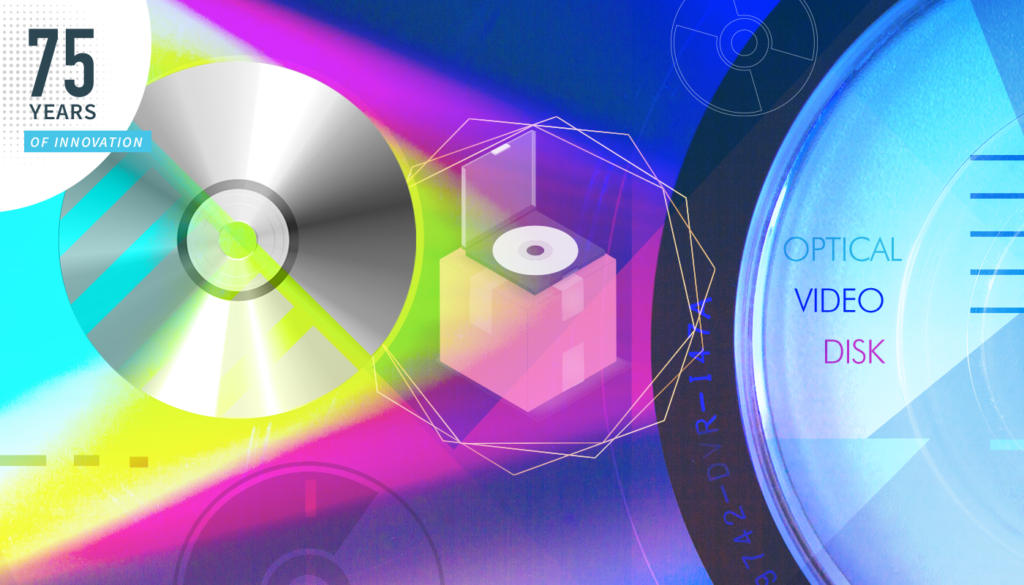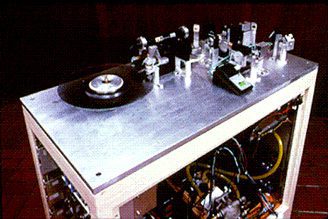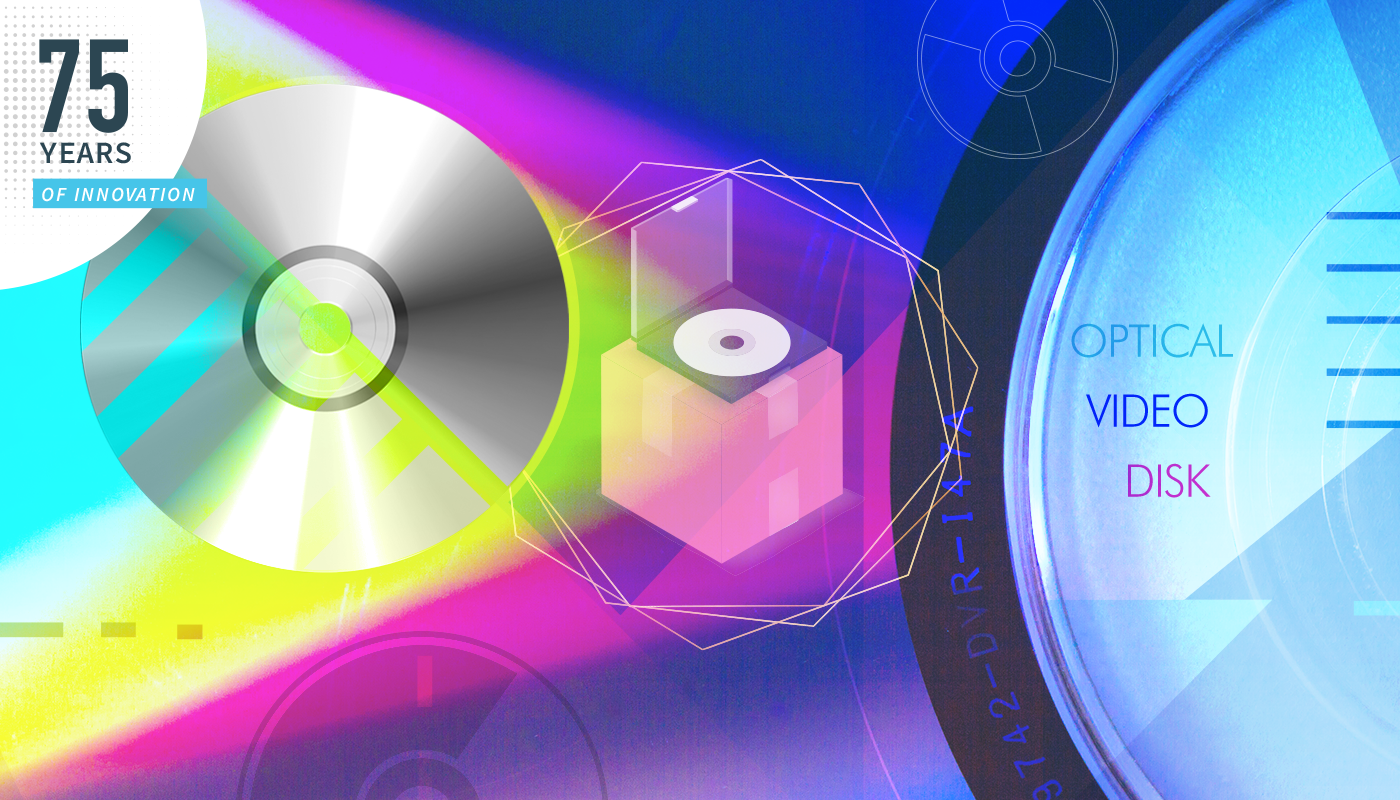The 75 Years of Innovation series highlights the groundbreaking innovations spanning from SRI’s founding in 1946 to today. Each week, SRI will release an innovation, leading up to its 75th anniversary in November 2021.

The 3M and SRI International collaboration is now a famous pairing on the road to how we experience everyday modern entertainment
Moving images: the optics of video disks
Back in 1961, 3M together with SRI International began research into a ‘photographic television disk’ that could carry sound and images. This resulting optical video disk would go on to revolutionize the way we watch TV. This creation would be used to set the bar for future innovations in data storage, such as Blu-ray disks and DVDs.
The 3M and SRI International collaboration is now a famous pairing on the road to how we experience everyday modern entertainment.
The magic of putting a TV program on a disk
The concept of capturing words on a disk sounds a little crazy when you write it on paper. Back in the 19th century, Thomas Edison, who was working on the telephone at the time, came up with the idea of creating a machine that could replay pre-recorded sounds. The phonographic record was the result of Edison’s delve into the recording of sound. Fast-forward to the mid-twentieth century and another leap of intellect took place: if you can put sounds onto a disk, why not pictures and moving images too?
It was the year 1961 and 3M had already been incredibly innovative around the applications of magnetic tape and audio recording. In 1954, RCA (now part of SRI International) used 3M Scotch® Magnetic Tape to record television programs for the first time. It was perhaps a natural extension of the two companies’ appetites to innovate that led 3M to approach SRI International with a request to further research the use of a phonograph record as a medium to carry TV signals.

3M recognized that the surface of a phonograph record was smooth enough so that any replicated detail applied had enough resolution to carry full-bandwidth television signals. SRI International had a wealth of pre-existing research that could be applied to research 3M’s initial thoughts. Developments around imaging technologies, including the development of the color TV from RCA Laboratories, meant that the right people for the job were available. With this in mind, SRI began to explore the feasibility of developing the world’s first optical video disk.
Cutting a groove into an optical video disk
Research into the use of a high-resolution phonograph disk resulted in the first prototype of a video disk, which was demonstrated in 1963.
The optical disk stored digital data representing both images and sound. The data is recorded and stored as a series of smooth areas and pits etched into the disk surface. As the disk spun, a laser scanned the surface, converting the pits into electric signals. In the 1963 prototype optical video disk, a helium-neon (He-Ne) laser was used. However, this prototype never moved into production due to the large size of the He-Ne laser. Instead, the He-Ne laser was eventually replaced by a mercury laser diode. In 1970, SRI researchers, including Philip Rice, published a paper that described an “Experimental television recording and playback system”. The TV system used a 12-inch photographic disk for storage, with the video and audio sync recorded as analog signals on a spiral track. Each 12-in diameter disk could store 30-minutes of a television program.
The joint research between 3M and SRI laid the groundwork for future work in the area of recording motion and sound onto a disk. The optical video disk was the precursor to commercial laserdiscs; the first of which entered the market in the 1970s. RCA Labs developed a version known as a “capacitance electronic disc” (CED), with the commercial name of “SelectaVision”. This version became obsolete in 1986.
The work done at SRI for optical video disks paved the way for the future of compact disk technology. By the mid-1980s, David Sarnoff Laboratories (now also part of SRI) would use sophisticated data compression and regeneration techniques to produce a technology system known as Digital Video Interactive (DVI). The DVI system was able to play over an hour of full motion, full-screen digital video from a standard CD-ROM.
The video disk comes of age
The research and development carried out by the 3M and SRI International collaboration ultimately led to the CD player and modern DVDs. However, technology rarely stands still; SRI is at the forefront of technological development across many fronts. It is this mix of disciplines that often leads to the most innovative approaches. When 3M came to SRI to develop a method of storing and playing back TV signals, one wonders if they knew this would take the world on a path to ever more effective data storage and playback mechanisms, from CD-ROM to DVDs to Blu Ray.
In 1963, Philip Rice was awarded the ‘IEEE Vladimir K. Zworykin Award’ for outstanding technical contributions in the field of electronic television.
Resources
P. Rice and R. F. Dubbe, “Development of the First Optical Videodisc,” in SMPTE Journal, vol. 91, no. 3, pp. 277–284, March 1982, doi: 10.5594/J01302.
P. Rice, A. Macovski, E. D. Jones, H. Frohbach, R. W. Crew and A. W. Noon, “An Experimental Television Recording and Playback System Using Photographic Discs,” in Journal of the SMPTE, vol. 79, no. 11, pp. 997–1002, Nov. 1970, doi: 10.5594/J13580.
IEEE Vladimir K. Zworykin Award: https://ethw.org/IEEE_Vladimir_K._Zworykin_Award
RCA Review 1978: https://worldradiohistory.com/ARCHIVE-RCA/RCA-Review/RCA-Review-1978-Sep.pdf



